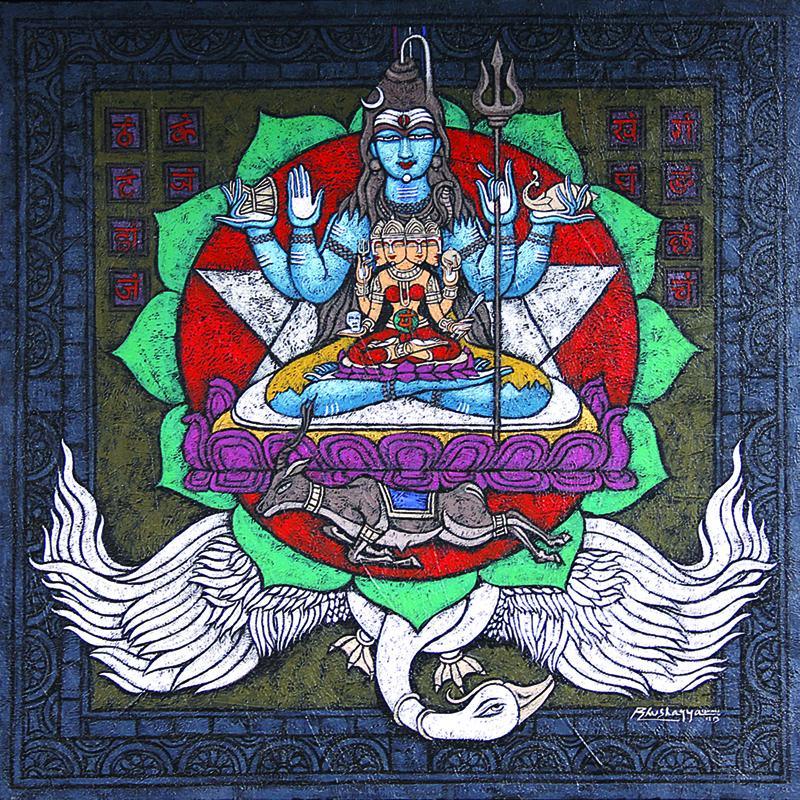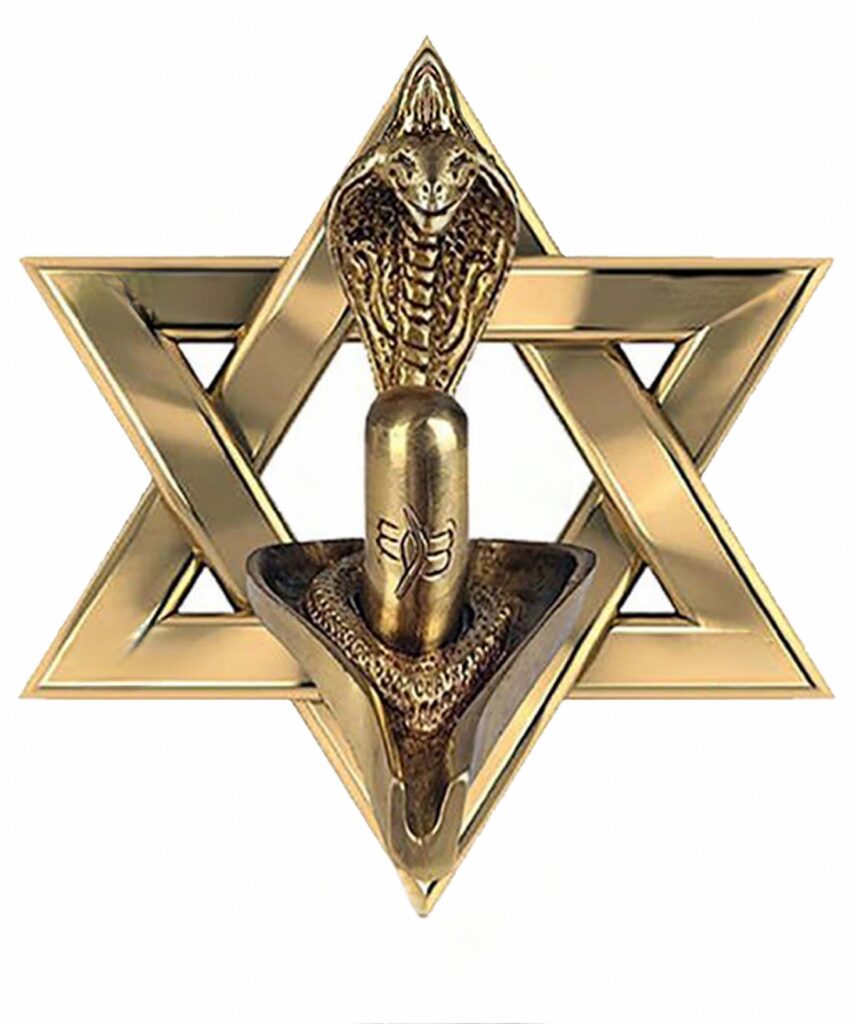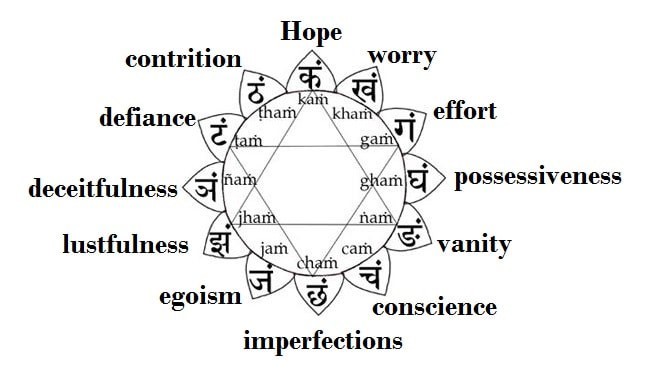
Within your heart is your is your divine self, (Atma).
Anahata means “unstruck”.
The function of Anahata is love and compassion.
It is represented as a lotus with twelve, green petals.
The Bija Mantra is YAM.
The element is air.
The sense is touch
The animal symbol or vehicle is the black antelope, alert and fleet footed.
Introduction
What does unstruck mean? The primordial sound that came from the void before there was matter. It formed matter. Sound occurs when objects strike each other and the vibration is carried through the air. Om is the sound from which the universe came from. Neither has been struck, Anahata, your true self is in your heart, underneath all experiences and emotions.
Within your heart is your essence, Jivatma (individual soul), your divine self, before it became clouded by perceptions and experiences. Your heart is a spiritual place of freedom and wonder; love, compassion, joy and gratitude. It is the home of your true self, before it was struck by hurt and trauma. Pure love arises in the heart without conditions, like the primordial sound.
The element of Anahata is air. “A breath of fresh air”. Air represents freedom, openness, expansion, freshness, spaciousness, lightness, and simplicity. Heart chakra represents the BREATH.
Air in motion is wind. It can develop immense power. Hurricanes and cyclones can uproot trees and destroy houses. Immense power also exists within the Anahata Chakra; it can be utilised positively or negatively. Anger and fury can devastate everything positive and beautiful that we have built in our lives; but the power of love is capable of achieving miracles.
The sense of touch is associated with Anahata. Our skin is the largest organ of the body. It senses and absorbs what you touch. The sensory faculty of touch has the power to draw you away from spiritual pursuit. One could become lost in the seductive world of pleasant sensual touch or one can control sensual desires and find the spiritual joining of the self with the universe.
The middle way is a path between indulgence and an aesthetic, who denies all senses and their body. When a string is too tight it will break, when it is too loose, it will not play. When the sting is in tune, it plays harmoniously. This is the middle way of Anahata, the meeting place of the body and the spirit.
The motor faculty is the dexterity of our hands.
You have a choice when facing past or present hurt: hold onto it or let it go. Choosing to release pain and suffering opens your heart to new connections and experiences, fostering compassion, love, and understanding. Conversely, clinging to hurt cultivates negativity and blocks opportunities for love.
It’s beneficial to process trauma, potentially with the help of practices like chakra work or professional psychology. Once processed, let it go. Avoid replaying past hurts, as this keeps your mind in a state of perceived threat. Your past traumas shouldn’t define you; instead of being a victim, choose to be a winner. Holding onto pain is a tactic of the mind and ego, while your spirit yearns for freedom.
Letting go of pain is a conscious choice. Living from the Anahata (Heart) Chakra means embracing love, forgiveness, and compassion for yourself and others. Remember that those who inflict pain often act from fear, ignorance, or hatred—all signs of a closed heart. Forgiving others is primarily for your own peace, freeing your heart from pain and filling it with joy.
Ultimately, giving and receiving love is fundamental to human nature. Practice self-love by shedding negative self-talk and unrealistic expectations. Cultivate gratitude, release ego, and simply be love. Open yourself to connection, compassion, and acceptance of life as it is, allowing yourself to find joy.
The Symbol

The Shatkona
Two triangles link together to form a star called Shatkona. The Shatkona is a very ancient and mystical symbol, thousands of years old. It is formed by two triangles interwoven together.
The upward pointing triangle points to heaven. It resonates with the vibration, Om. It symbolizes the male aspect, Shiva, the supreme being and fire. The primordial sound is Om and it is embedded in the upward facing triangle of Anahata.
The downward pointing triangle points to earth. It resonates with the vibration, Hreem. It symbolizes the female aspect Shakti, mother nature and water. They are opposites and cannot exist without the other.
When you meditate on the Shatkona in Anahata you will discover that it is two, spinning tetrahedrons (3 sided pyramids) with the upward pyramid rising through the centre of the downward pointing pyramid. This is the interpenetration of consciousness, Purusha, and unconsciousness Prakti. The stillness of true nature and the activity of nature. Prakti is responsible for activating Purusha.
This is how we feel love and compassion. When we exist in pure consciousness, Purusha, we are in complete stillness and emptiness. The energy of our ever-changing world, Prakti, excites our heart and we feel emotions.
The six points of the triangle represent the six heads of Kartikeya, the offspring of the male and female energy. Kartikeya is the mighty god of war created to combat demons that symbolize negative tendencies in people. His six faces, point in the direction of the six points of the Shatkona to help him see problems coming from all directions and combat those who may lead us in the direction of the 6 ripu: Kama (lust), krodha (anger), lobha (greed), mada (arrogance), moha (delusion), and matsarya (jealousy).
The kundalini serpent appears in the upward pointing triangle of the heart chakra. The kundalini energy is no longer coiled three & a half times around the lingam; it is moving upward to higher spiritual planes. The energy is calm and serene, not the destructive energy found in Muladhara chakra.
In the center is an eternal flame that stands for the Jivatma (individual soul).the Divine Soul or Higher Self. The Jivatman, is represented by the image of a motionless golden lamp-flame.
When energy moves down toward lower consciousness, it is expressed as connection with the body and the material world. The upward pointing triangle represents the material world rising to meet the spirit. When one’s energy is moving in an upward direction, the heart chakra can express itself as unconditional love, which leads toward spiritual liberation. Art, music and poetry created under the influence of Kakini, the female deity, brings calmness to the mind and peace to the ego and intellect. The creativity endeavours made under her auspices can become so absorbing that one’s sense of I-consciousness dissolves away.
The Vrittis of Anahata

The mind is a flow, or vibration of energy which is an expression of the dynamic flow of the cosmos. In order to express this flow the mind adopts vrittis, or methods of expression.
There are 12 lotus petal in Anahata, each with a symbol, sound and vritti , or emotion. Each vritti can become positive or negative depending on if our energy is moving downward and connecting with matter and the body, or if we are on a spiritual quest. If our lives are focused on a physical level, the vrittis translate to negative emotions. If one is connecting to spirit, the vrittis became positive.
The syllables symbolically represent the vital energy that comes from the 12 nadis, or air channels that meet in the heart centre.
- क ka, kam: Asha – Hope, wish.
- ख kham: Cinta – Thoughtfulness, worry.
- ग gam: Cesta – Effort.
- घ gham: Mamata – Love, Possessiveness.
- दं ngam: Dambha – Pretention, vanity.
- च cam: Viveka – Awareness, discrimination.
- छ cham: Vikalata – Mental inertia.
- ज jam: Ahamkara – Ego.
- झ jham: Lolata – Avarice.
- इन nam: Kapata – Hypocrisy, pretence.
- त tam: Vitarka: Thinking.
- ठ tham: Anutapa: Repentance.
Ka, Kam: Asha – Hope, joy, optimism, happiness, pleasure.
- Always keep hope alive. Ka is the name of the soul in Ancient Egypt.
kha, khaṁ: cinta – consideration, care, anxiety, worry
- Worrying is a waste of energy. If you have a problem and can do something about it then do it, then you will have no reason to worry. If you can’t do anything about it, then it is pointless worrying about it. Don’t worry about imaginary situations that are more than likely not to happen.
ga, gaṁ: cesta – effort, endeavour
- This is the enormous effort made to arouse potential through the development of spirituality, to elevate the self from the mundane.
gha, ghaṁ: mamata – possessiveness, fondness, love
- If you really love someone, you will not feel the need to own or possess them. When you love someone you will want the best for them, you don’t need them to complete you if you are already complete in yourself. you can add to their life experience, rather than wanting them to give to you.
una, naṁ: Dambha – hypocrisy, pride, arrogance, vanity
- a lack of genuine sincerity in spiritual practices, and the pursuit of outward displays of virtue over inner transformation. Always be humble and grateful.
ca, caṁ: Viveka – Awareness, discrimination
- The ability to differentiate between the real and the unreal, the permanent and the temporary, the Self and the non-Self. Chose right over wrong, kindness over cruelty, spirituality over transitory things. Remember that objects only give you momentary happiness. True joy is inside us.
cha, chaṁ: vikalata – Discomfort, deficiency, imperfect, incompetence.
- If the mind malfunctions, seek spiritual help to give you shelter. Don’t let your mind rest in laziness.
ja, jaṁ: ahamkara – egoism
- identification of the self with impermanent things, like the body or experiences.
jha, jhaṁ: lolata – Greed, avarice
- Greed for money and other things will turn you into a miser and make you miserable. Practice doing service for others, avoid luxury and use what is necessary for you. Do not want things that don’t belong to you, this leads to unhappiness for yourself and pain for others. Learn to master your passions and desires.
ina, nyaṁ: kapata – duplicity, deceitfulness, hypocrisy
- Do not cheat or exploit others. Do not dominate someone to conceal your own ignorance or weakness. Do not pretend to be moral by criticizing the mistakes of others, which one secretly commits oneself. Don’t pretend to be what one is not, or feeling what one does not feel.
ta, taṁ: vitarka – Thinking
- Vitarka is the mind’s first impression of an object. It can be a focus of attention to prepare the mind for deeper meditation, or it can be a distraction when objects are evaluated by the senses.
tha, thaṁ: anutapa – repentance, remorse, contrition
- Anutapa describes a deep feeling of sympathy and pity for the sufferings of others, coupled with a desire to help. It can also be a feeling of remorse for past wrongs and a resolve to change for the better.
Hrit chakra
Below the 12-petal primary lotus, there is a secondary chakra, Hrit chakra, a lotus with eight petals enclosing a Kalpataru, means wish-tree that yields fruits of desire. Yogis see this six-angled shape in their mind’s eye as a lake (Manasarovar) with a blue Lotus. This is a Yogic asset; a perfect yogi can realize their wishing. However, misuse of which can be disastrous.
Next to come… the deities in Anahatsa